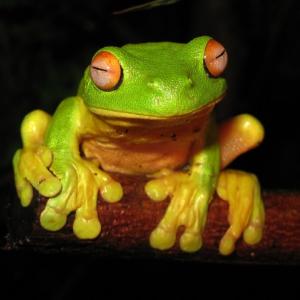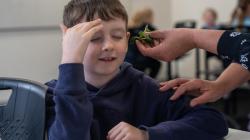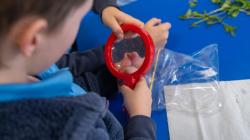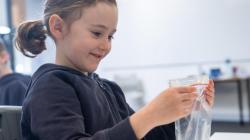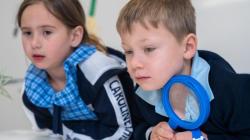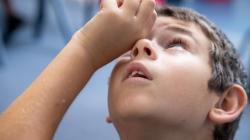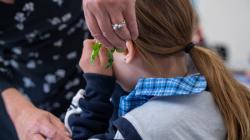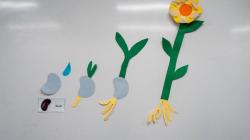'Finding features' is one of our new teaching sequences for AC V9
- On the 'Sequence overview' tab you'll find all the lessons in this sequence and curriculum alignment.
- The 'Our design decisions' tab shows how key scientific ideas develop over the sequence, and shows how the sequence addresses curriculum achievement standards.
- The 'Preparing for this sequence' tab guides you through important information and considerations for this sequence.
- Have you taught this sequence? Use the Feedback button to let us know how it went!
Launch
Lesson 1 • Using senses to observe
Students use their senses to make observations about the features of plants and animals.
Inquire
Lesson 2 • Seeds and leaves
Focusing on the senses of sight and hearing, students observe the growth of plants from seeds and group leaves according to the sounds they make, as well as their patterns, shape or size.
Lesson 3 • Flowers
Focusing on the senses of sight and smell, students make observations about the features of flowers.
Lesson 4 • Plants we can eat
Focusing on the senses of sight and taste, students explore edible parts of plants and sort the components of a salad bowl. Alternatively, take a closer look at the mysterious underground parts of plants (the roots).
Lesson 5 • Animal features
Focusing on the sense of sight, students identify and group animals based on their external features such as tails, fur, legs, etc.
Lesson 6 • Animal movement
Focusing on the sense of sight, students explore animal movement and the features that make movement possible.
Lesson 7 • Body coverings and feeding
Focusing on the senses of sight, hearing and touch, students explore the features of body coverings and those that enable animals to feed.
Act
Lesson 8 • Modelling plant or animal features
Students (as scientists) create and share a model of a plant or animal explaining its external features.
The Australian Academy of Science supports and encourages broad use of its material. Unless indicated below, copyright material available on this website is licensed under a Creative Commons Attribution-NonCommercial-ShareAlike 4.0 International (CC BY-NC-SA 4.0) licence.
Curriculum and syllabus alignment
Achievement standards
Students group plants and animals based on external features. They identify examples of people using observation and questioning to learn about the natural world.
Students pose questions and make predictions based on their experiences. They engage in investigations and make observations safely. With guidance, they represent observations and identify patterns. With guidance, they compare their observations with their predictions. They share questions, predictions, observations and ideas about their experiences with others.
Australian Curriculum V9 alignment
Science as a human endeavour
Explore the ways people make and use observations and questions to learn about the natural world
Science understanding
Observe external features of plants and animals and describe ways they can be grouped based on these features
Science inquiry
Pose questions and make predictions based on experiences
Engage in investigations safely and make observations using their senses
Represent observations in provided templates and identify patterns with guidance
Compare observations with predictions with guidance
Share questions, predictions, observations and ideas with others
Australian curriculum content links
| Science understanding core concept: The form and features of living things are related to the functions that their body systems perform. |
| Sub-strand | Content descriptor | AC code | Achievement Standard | How the sequence addresses this content |
|---|---|---|---|---|
| SHE: Use and influence of science | Explore the ways people make and use observations and questions to learn about the natural world. | AC9SFH01 | Identify examples of people using observation and questioning to learn about the natural world. | Use their senses to make observations and explore how scientists use their senses as well as equipment to make observations. (Lessons 1-7) View examples of rock paintings, bark drawings, labelled drawings and photographs to explore ways to make and record observations. (Lessons 1-7) Explore how First Nations Australians gain knowledge about plants and animals through observation. (Lesson 5, 6) |
| SU: Biological Sciences | Observe external features of plants and animals and describe ways they can be grouped based on these features.
| AC9SFU01 | Group plants and animals based on external features. | Using magnifying glasses or digital cameras/iPad to observe and identify external features of plants and animals. (Lesson 1-3, 5, 6) Observe fruits and vegetables and identify them as parts of plants such as roots, flowers, fruits, seeds or leaves. (Lesson 2-4) Sort collections of model animals and/or photographs and explain grouping strategies. (Lessons 3-7) Recognise humans as animals, describing external features of humans and exploring similarities and differences with other animals. (Lesson 6) |
| SI: Questioning and predicting | Pose questions and make predictions based on experiences.
| AC9SFI01 | Pose questions and make predictions based on experiences. | Use their senses to predict what plants and animals they can feel, smell, hear, see and taste (edible plants only.) (Lessons 1-7) Use their experiences to predict which animals they might hear and see in the schoolyard. (Lessons 6, 7) |
| SI: Planning and conducting | Engage in investigations safely and make observations using their senses.
| AC9SFI02 | Engage in investigations and make observations safely. | Use tools such as magnifying glasses and iPad/digital cameras to enhance their observations of plants and animals. (Lesson 1-3, 5, 6) Explain safety considerations for using senses of touch, smell, sight and hearing and why we don’t use taste in science to make observations. (Lessons 4, 6, 7) |
| SI: Processing, modelling and analysing | Represent observations in provided templates and identify patterns with guidance. | AC9SFI03 | With guidance, represent observations and identify patterns. | Create leaf rubbings to identify leaf structure, similarities, differences, patterns. (Lesson 2) Explore the use of sketches, diagrams and tables through a class science journal (teacher to model). (Lesson 2-7) |
| SI: Evaluating | Compare observations with predictions with guidance. | AC9SFI04 | With guidance, compare observations with their predictions. | Compare observations to predictions. (Lesson 7) |
| SI: Communicating | Share questions, predictions, observations and ideas with others. | AC9SFI05 | Share questions, predictions, observations and ideas about their experiences with others. | Represent external features of a plant or animal using a range of materials such as playdough, clay and craft materials or digitally in apps such as Paint. (Lesson 8) |
Science journals
Create a class science journal, either in hard-copy or digitally. You might:
- use/create a large scrap book or flip chart.
- use poster/butchers’ paper so learning can be displayed in sequence on the wall.
- create a digital journal using your platform/technology of choice.
- any combination of the above.
Plan for students’ creation of an individual science journal, either in hard-copy or digitally. They might:
- use an exercise book, scrap book or flip chart to record their thinking and gather resource sheets together.
- use a folder to store and collate resource sheets, diagrams, photographs etc.
- use a digital folder to store work samples, images and videos.
- any combination of the above.
See Using a science journal throughout inquiry for more detailed information on the importance of science journals.
General preparation
- Read through the teaching sequence.
- Prepare enlarged copies of Resource sheets as appropriate.
- Print, cut out and laminate the Animal cards from the Animal cards Resource sheet.
- Note any adaptations you would like to make to suit your school’s and students’ context.
- Determine and plan for the audience for students’ final presentation of the plant/animal model. You might choose to present to classmates, other classes, parents, display models in an appropriate location in the school, or prepare and publish a digital gallery of video and photos to a closed/private school platform.
- Consider setting up an area in the classroom where you can build a 'nature table' over the course of the sequence. This 'table' will be a place to collect specimens of plants and animals as appropriate, or images of plants and animals. It can be used to spark conversation and curiosity about plants and animals.
Allergies
Lessons 1-4 and Lesson 6 of this sequence involve students being in close contact with plants and the school grounds. There is a risk that students may have an allergic reaction to some plants, or the insects that are often found near plants (particularly bees), including a life-threatening anaphylactic reaction.
It is essential that you are aware of any allergies your students may have. Consult your school’s Health and Safety Policy for information on how to mitigate these risks in your context.
Food allergies
Lesson 4 of this sequence involves students touching and potentially tasting plant-based foods.
There is a risk that students may have an allergic reaction to foods, particularly peanuts, tree nuts (almonds, brazil nuts, cashew nuts, hazelnuts, macadamia nuts, pecan nuts, pine nuts, pistachio nuts, walnuts etc.) and lupin beans, including a life-threatening anaphylactic reaction.
It is essential that you are aware of any allergies your students may have. Many schools have policies about specific foods being banned from school premises. Consult and follow your school’s Health and Safety Policy for information on how to remove these risks in your context.
An alternative investigation is offered in Lesson 4 if the food-based investigation is not suitable for your students or context.
Animal ethics
Lessons 5-7 of this sequence describe investigations of invertebrate animals. Each Australian state and territory has animal ethics requirements for school investigations involving vertebrate animals (those with a backbone such as birds or guinea pigs). You would need to comply with any requirements of the relevant Animal Welfare Act if you chose to investigate vertebrate animals, including a therapy dog.
Insects and crustaceans are invertebrate animals and are not covered by the Animal Welfare Act but still require care and consideration.
Each school and state might also have policies in place addressing animal welfare in classroom settings. Consult and follow the relevant policies.
Lungworm risk mitigation
A variety of snails, slugs and planarians are suitable intermediate hosts of the rat lungworm, Angiostrongylus cantonensis. Human infection occurs following ingestion of raw snails, slugs or planarians, something young toddlers are particularly prone to do. Another possible source of human infection is through ingestion of improperly washed vegetables such as lettuce.
It is recommended that the following safety procedures be followed during this sequence:
- Wear gloves when handling any biological material.
- Always wash hands with soap and water after handling any biological material (particularly snails, slugs or their slime, and any vegetation such as vegetables or leaf litter), even after wearing gloves.
- When handling snails or slugs, keep hands away from the mouth, and clarify with students that they should never encourage, or dare anyone to eat raw snails or slugs.
Providing parents with information and seeking permission
Consider sending home information notes, with permission forms attached, to inform parents about the nature of this teaching sequence, seeking up-to-date information about any allergies students may have, and seeking permission for students to take part.
Making adaptions for safety reasons
Consider any changes you may need to make to ensure that all students can participate safely in the sequence. Some adaptions may include:
- avoiding any specific plants that have been identified as allergens for any student in your class.
- having emergency anaphylaxis medications, such as the EpiPen® or AnaPen®, on hand in the classroom for any potential emergency.
- allowing parents to be present for lessons to supervise students with known or potential allergies.
- using artificial plants/flowers and food samples when required.
The materials required for each lesson are listed on the lesson's page. For the full sequence resource list, download the Preparing to teach this sequence document below.
